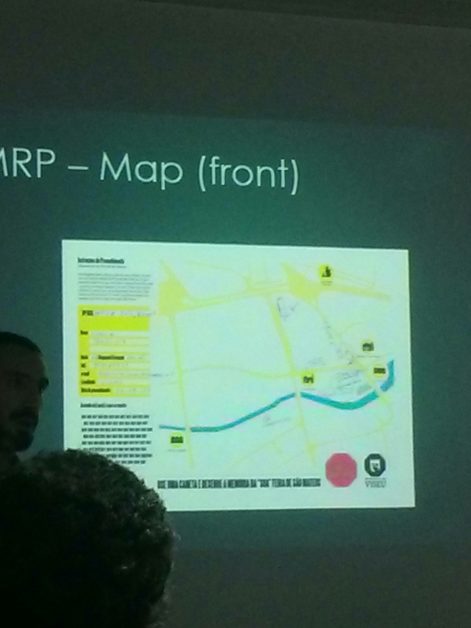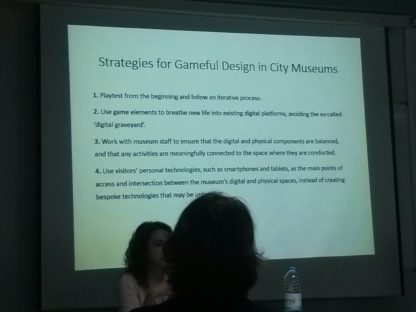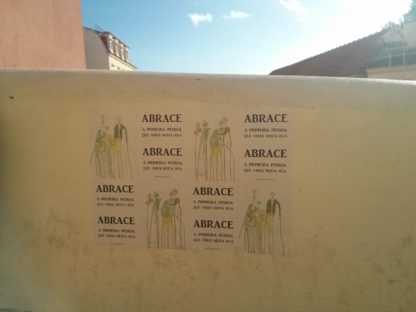The participation at a conference is a great opportunity for discussing topics and collectively finding new answers, but not exclusively. It is also a place where more questions and provocations trigger more quest for knowledge and solutions. When going to the “Lost and Transformed cities: a digital perspective” conference in Lisbon on the 17th and 18th of November, Katharina Böttger and I knew that our talk was not only about presenting the new Stadtlabor Digital platform, but most definitely trying to look for some reactions. Little did we know that more interrogations, but also interesting insights would help us come back to Frankfurt with new experiences and new motivation to understand and make the best out of the experience the Historisches Museum Frankfurt and our digital curator Franziska Mucha are preparing for the visitors in 2017.
Our questions revolved the possibility of integrating the many perspectives of Frankfurters in the museum with this new digital platform. The consequences of such an endeavor are also among the inquiries that once in a while make us reflect upon new museological practices and the use of digital technologies. We were happy to present our paper in a very interesting afternoon with the main topic of virtual museums, but that also approached topics such as “gamefication” and interactive experiences in museums. We heard of some examples of other countries that, similarly to museums around Germany, are already implementing similar systems to involve its visitors. It was possible to participate at a very interesting discussion afterwards, together with the other speakers and the moderation of Lisbon Museum director Joana Sousa Monteiro.
Among the aspects worth retaining from the conference and consequently applying to our own work, some may reside in stretching even further the limits of providing places of wonder and creativity. Places where people can create freely, be activated and engaged, with the intention not only to increase their number of visits and time spent in the museum, but also making meaningful learning and empowering experiences. Another insight to be retained is the need to provoke people. In museums, the intention should be not only the transferring of knowledge but also to incite people to make decisions, whether it is by taking part in games, storytelling or other interactive activities, making a sort that the visitor’s own sense of action may be responsible for his particular and rewarding experience.
Furthermore, it’s also important to stress the need of interaction among people in the museum. Communication is one of the best ways of learning, which can be completed by the fact that knowledge is more democratic and plural when created together by people. Consequently, this dialogical approach between the museum and its public but also among the visitors, especially through participatory activities can have an impact on the museum’s relevance, affecting people’s experience of the space, the city, creating shared knowledge about a specific place, but also sense of ownership and empowerment.
The use of digital technologies was highly explored during the conference. Especially as a way of creating virtual representation of lost ancient cities, but also revealing a potential that such immersive experiences combined with the embodiment of once fully inhabited places of which today no more than archeological traces remain, are able to provide learning experiences whether it is inside museums or not. Nevertheless, the uses of such technologies were constantly questioned during the conference. What’s the role of these technologies after all?
Digital technologies and the internet as a virtual space are then instruments to reach more goals regarding the scope of action of museums, but also helping shape this creative space filled with enormous potential to connect people. It was stated nevertheless that not only by using screens and smartphones in museums, for example, it is possible to create experiences. Also by sound and other physically based activities, individuals are encouraged to explore a territory or a city; not only in museums but also in parks and other public spaces, by using Wi-Fi in and exploring an app, people can find tools that inspire them to actively participate in the decision-making process concerning the design of such places; that recorded and shared performances of occupying urban spaces are a way of rethinking and re-appropriating the city. Finally, that it is possible to use a digital platform in a museum as virtual social theater and an approach of modifying the way people perceive the city and the relevant place the museum intend to be for them. For these and many other inspirations we would like to thank the many speakers that were at the conference, hoping to meet them again and hear their new experiences whether it’s in a digital or a concrete space.



0 Kommentare zu “A digital higher perspective”